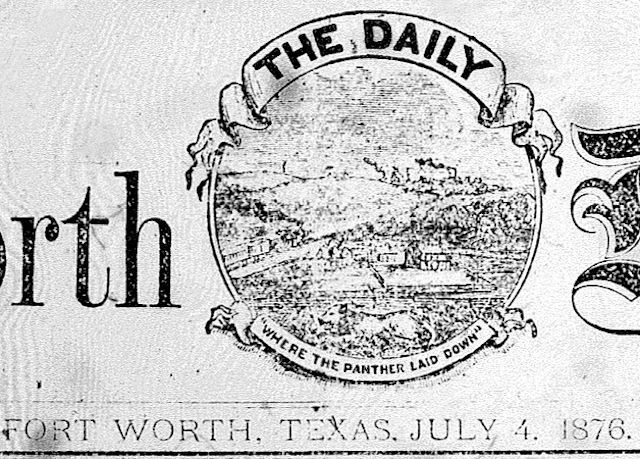 The nameplate introduced atop the front page of the Daily Democrat on July 4, 1876 served two purposes: It celebrated the imminent arrival of the railroad (see Part 1) in Fort Worth, and it turned Dallas’s 1875 “panther” gibe in the Herald on its head and made the panther a symbol of pride, not shame. At the eight o’clock position on the circle can be seen a train, its engine billowing black smoke. At the six o’clock position can be seen a panther at rest.
The nameplate introduced atop the front page of the Daily Democrat on July 4, 1876 served two purposes: It celebrated the imminent arrival of the railroad (see Part 1) in Fort Worth, and it turned Dallas’s 1875 “panther” gibe in the Herald on its head and made the panther a symbol of pride, not shame. At the eight o’clock position on the circle can be seen a train, its engine billowing black smoke. At the six o’clock position can be seen a panther at rest.
Part 3 of this three-part post concentrates on Fort Worth’s rivalry with Dallas as the Texas & Pacific tracks inched ever closer to Cowtown.
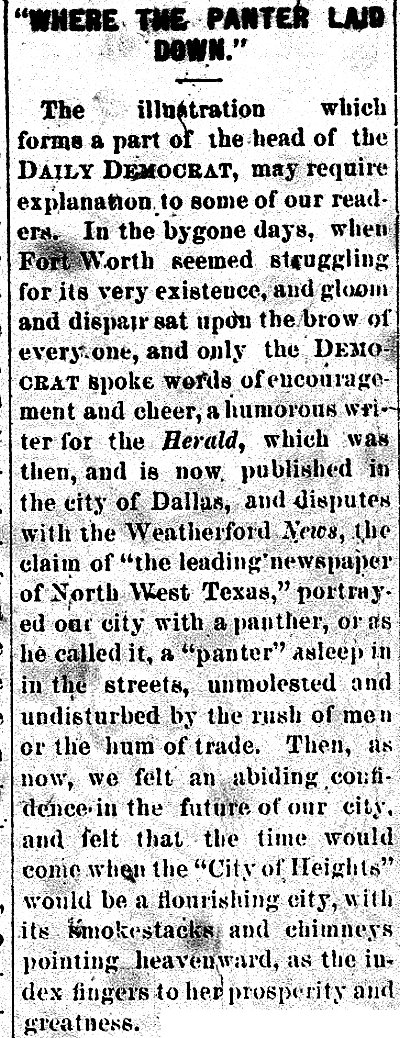 On July 4, 1876 the Democrat explained the panther image and the “Where the Panther Laid Down” slogan of the new nameplate. The Democrat reminded readers that when Dallas had been portraying Fort Worth as a sleepy place devoid of “the rush of men or the hum of trade,” the Democrat never lost confidence in its city.
On July 4, 1876 the Democrat explained the panther image and the “Where the Panther Laid Down” slogan of the new nameplate. The Democrat reminded readers that when Dallas had been portraying Fort Worth as a sleepy place devoid of “the rush of men or the hum of trade,” the Democrat never lost confidence in its city.
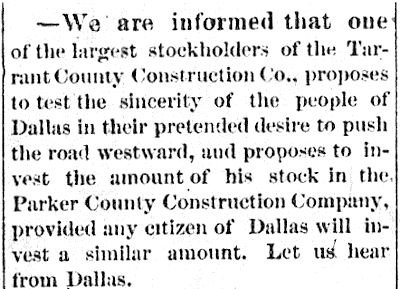 Fort Worth had accused Dallas of not wanting the railroad to extend west past Dallas. On July 8 the Democrat challenged Dallas to prove that it was serious about wanting the railroad to extend westward. (The Tarrant County Construction Company had been formed to lure T&P to Fort Worth.)
Fort Worth had accused Dallas of not wanting the railroad to extend west past Dallas. On July 8 the Democrat challenged Dallas to prove that it was serious about wanting the railroad to extend westward. (The Tarrant County Construction Company had been formed to lure T&P to Fort Worth.)
 In this exchange between the Herald and the Democrat on July 14, with the railroad just five days away from Fort Worth, the Herald politely congratulated the Democrat on becoming a daily newspaper but took credit for inspiring the Democrat’s new nameplate and doffed “the editorial beaver [hat]” with many wishes for success. The Democrat took the Herald’s words as a confession and said “the Dallasites who have lorded it over Fort Worth in such royal manner, . . . can now . . . chew the bitter cud of remorse.” The Democrat added: “The storm has come. Dallas is built upon the sand, Fort Worth upon a rock. But we will not hit them too hard now that they are down, though when we were down, they showed us no mercy.”
In this exchange between the Herald and the Democrat on July 14, with the railroad just five days away from Fort Worth, the Herald politely congratulated the Democrat on becoming a daily newspaper but took credit for inspiring the Democrat’s new nameplate and doffed “the editorial beaver [hat]” with many wishes for success. The Democrat took the Herald’s words as a confession and said “the Dallasites who have lorded it over Fort Worth in such royal manner, . . . can now . . . chew the bitter cud of remorse.” The Democrat added: “The storm has come. Dallas is built upon the sand, Fort Worth upon a rock. But we will not hit them too hard now that they are down, though when we were down, they showed us no mercy.”
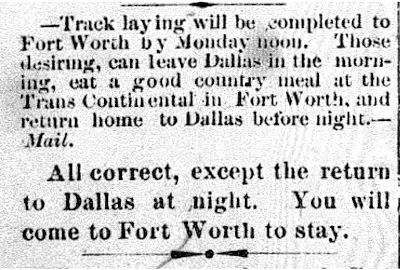 In a lighter tone, on July 16 the (possibly Dallas) Mail newspaper said Dallasites would be able to take the train over to Fort Worth, spend the day, and return by night. The Democrat corrected that notion, predicting that Dallasites would be won over and stay in Cowtown.
In a lighter tone, on July 16 the (possibly Dallas) Mail newspaper said Dallasites would be able to take the train over to Fort Worth, spend the day, and return by night. The Democrat corrected that notion, predicting that Dallasites would be won over and stay in Cowtown.
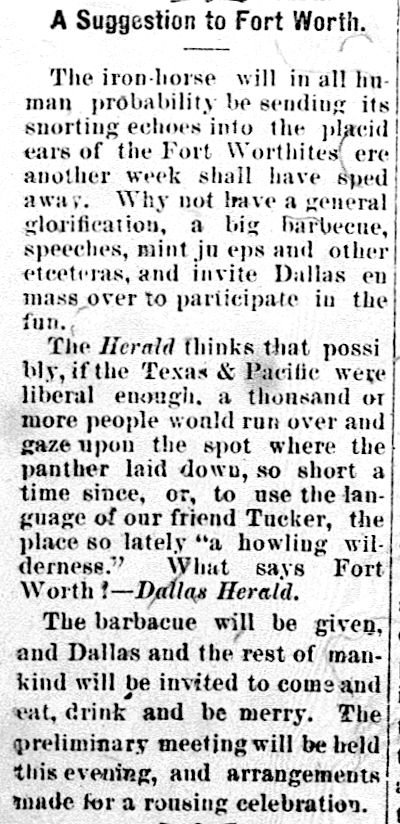 On July 18 the Herald suggested that Dallas be invited en masse to the grand jollification (Part 2) in Cowtown but couldn’t resist again referring to Fort Worth as “where the panther laid down” and “so lately a howling wilderness.” As the Democrat responded in the last paragraph, you can almost feel the Democrat biting its tongue.
On July 18 the Herald suggested that Dallas be invited en masse to the grand jollification (Part 2) in Cowtown but couldn’t resist again referring to Fort Worth as “where the panther laid down” and “so lately a howling wilderness.” As the Democrat responded in the last paragraph, you can almost feel the Democrat biting its tongue.
 And on July 21, two days after the first train arrived in Fort Worth, the Herald called Fort Worth a “village.” The Democrat hissed back, calling Dallas “Cougartown” and taunting Dallas with the proposition that its merchants would relocate to “Pantherville.” Then, in response to a report by the Democrat that two deer had been seen on a street in town, the (possibly Pine Bluff) Commercial newspaper tag-teamed with the Herald, suggesting that Fort Worth lease itself for hunting. The Democrat responded by taking another swipe at Dallas and suggesting that Dallas lease itself for cattle pastures. Meow!
And on July 21, two days after the first train arrived in Fort Worth, the Herald called Fort Worth a “village.” The Democrat hissed back, calling Dallas “Cougartown” and taunting Dallas with the proposition that its merchants would relocate to “Pantherville.” Then, in response to a report by the Democrat that two deer had been seen on a street in town, the (possibly Pine Bluff) Commercial newspaper tag-teamed with the Herald, suggesting that Fort Worth lease itself for hunting. The Democrat responded by taking another swipe at Dallas and suggesting that Dallas lease itself for cattle pastures. Meow!
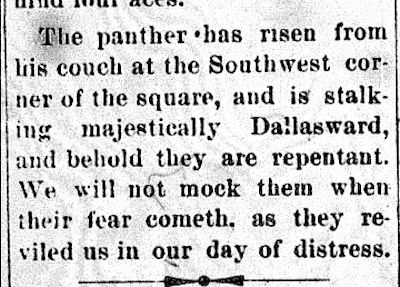 By July 25, after weeks of first anticipation and then celebration, editor B. B. Paddock and the Democrat seemed to be framing the Fort Worth-Dallas rivalry in Old Testament terms: “. . . and behold they are repentant. We will not mock them when their fear cometh.” Holy Moses, Paddock! Picture ol’ B. B. wearing tunic and sandals and a flowing white beard. But we should remember the context. Fort Worth had waited a long time for its great iron equalizer. Paddock and the Democrat had kept the faith for three years. And now, at last, Fort Worth was ascendant: “The panther has risen.” Fort Worth—the sleepy “suburban village” where the “panther laid down” in 1875—had begun to roar on July 19, 1876 at 11:23 a.m. And for the next seventy-five years that roar would sound mighty like a steam locomotive.
By July 25, after weeks of first anticipation and then celebration, editor B. B. Paddock and the Democrat seemed to be framing the Fort Worth-Dallas rivalry in Old Testament terms: “. . . and behold they are repentant. We will not mock them when their fear cometh.” Holy Moses, Paddock! Picture ol’ B. B. wearing tunic and sandals and a flowing white beard. But we should remember the context. Fort Worth had waited a long time for its great iron equalizer. Paddock and the Democrat had kept the faith for three years. And now, at last, Fort Worth was ascendant: “The panther has risen.” Fort Worth—the sleepy “suburban village” where the “panther laid down” in 1875—had begun to roar on July 19, 1876 at 11:23 a.m. And for the next seventy-five years that roar would sound mighty like a steam locomotive.





